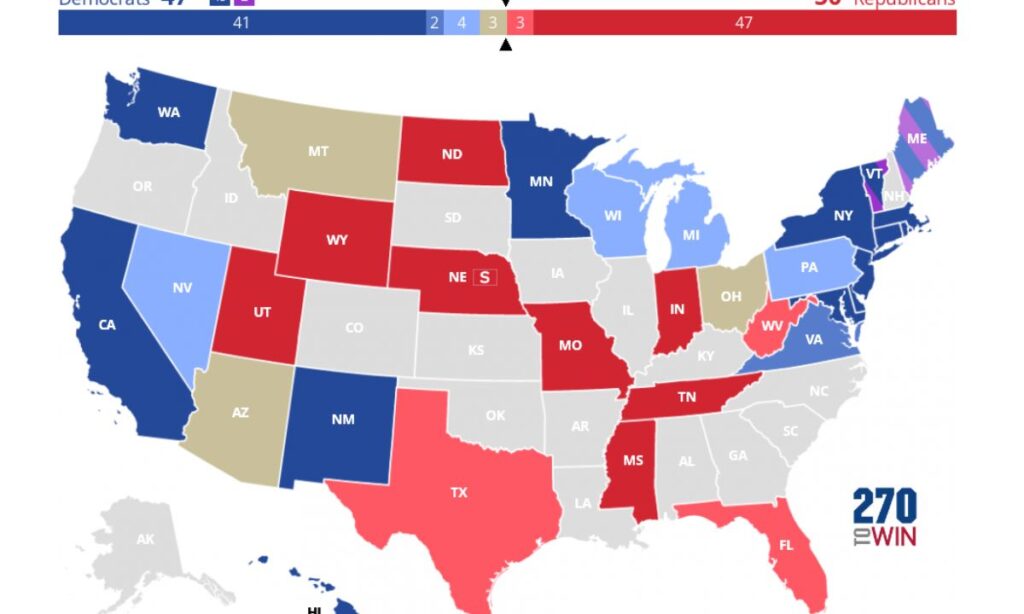In the realm of U.S. politics, the Senate forecasts for the 2024 election season paint a vivid picture of a highly competitive and pivotal contest. With Republicans strategically defending only 11 of the 34 Senate seats up for election, all of which are located in states carried twice by former President Donald Trump, and Democrats tasked with safeguarding 23 seats, including those in traditionally Republican states, the stakes are exceptionally high.

The Senate Forecasts Cook Political Report’s Analysis
A recent analysis by the esteemed Cook Political Report provides valuable insights into the likely outcome of the 2024 Senate Forecasts election. According to their forecast, Republicans currently hold an advantage and are favored to gain a net of two seats in the upcoming election. Such a shift would reverse the current Senate composition, where Democrats maintain a narrow 51-49 majority.
Nonetheless, it’s paramount to recognize that the Senate electoral landscape is replete with competitiveness, with a multitude of races on a knife’s edge. Let’s delve into the key races that are poised to shape the 2024 Senate election:
Arizona:
In Grand Canyon State, incumbent Democrat Mark Kelly faces re-election in an environment that has become progressively competitive in recent years. Republicans are gearing up for a robust challenge, ensuring that this race will be closely scrutinized on the national stage.
Georgia:
Georgia, once a Republican stronghold, has emerged as a battleground state in recent election cycles. Incumbent Democrat Raphael Warnock, who secured his seat through a special election in 2021, faces an ardent Republican challenge in 2024, making this race another focal point of attention.
Montana:
In Big Sky Country, incumbent Democrat Jon Tester seeks re-election in a state that has witnessed a gradual shift toward Republican dominance. Tester, a popular incumbent, is nonetheless bracing for a formidable Republican challenge, setting the stage for a closely contested race.
Ohio:
The Buckeye State is another battleground where incumbent Democrat Sherrod Brown seeks re-election. Ohio’s recent Republican tilt presents a challenging scenario for Brown, who enjoys popularity but must contend with a resurgent Republican presence.
West Virginia:
West Virginia, known for its deeply conservative leanings, may witness an intriguing contest should incumbent Democrat Joe Manchin decide to seek re-election. Manchin, a moderate Democrat who has shown willingness to break with his party, could potentially face a robust Republican challenge if he chooses to run in 2024.
Beyond these pivotal races, a host of other Senate forecasts contests across the nation remain in a state of flux. Democrats aim to challenge Republican incumbents in states including Florida, Iowa, North Carolina, and Pennsylvania. Simultaneously, Republicans are eyeing opportunities to unseat Democratic incumbents in states such as Michigan, Minnesota, and Nevada.
The outcome of the 2024 Senate election holds immense consequences for the Biden administration’s ability to enact its policy agenda. Should Republicans seize control of the Senate, they would possess the power to block President Biden’s legislative initiatives. Conversely, if Democrats retain Senate control, they can propel forward Biden’s policy agenda and secure confirmation for his judicial nominees.
Key Determinants of the 2024 Senate Election Outcome
Several influential factors could sway the outcome of the 2024 Senate election:
The Economy:
Economic conditions perennially serve as a linchpin in electoral dynamics, and 2024 is no exception. A robust economy in that year would likely bolster Democrats’ prospects, while economic challenges or stagnation could favor Republicans, who may position themselves as the party best equipped to address economic stability.
Inflation:
Inflation, another critical economic factor, looms large on the political horizon. Its recent surge and the likelihood of its continued presence in 2024 make it a significant issue. High inflation could potentially work to the advantage of Republicans, who may portray themselves as the solution to economic stability.
President Biden’s Approval Rating:
The approval rating of President Biden, which currently stands at a relatively low level, remains a subject of scrutiny. The trajectory of his approval rating leading up to 2024 is uncertain, but a sustained low rating could prove detrimental to Democrats’ prospects in the Senate election.
The Candidates:
The quality and appeal of the candidates put forth by each party will undoubtedly exert a profound influence on the 2024 Senate election. Strong and charismatic candidates have the potential to bolster their party’s chances, while weaker candidates may hinder their electoral prospects.
COnCLuSION
In conclusion, the 2024 Senate Forecasts election is poised to be fiercely competitive and closely watched. While Senate forecasts currently indicate a slight advantage for Republicans, the dynamic nature of politics suggests that the outcome remains uncertain due to the number of closely contested races. The results of this election will undoubtedly have far-reaching implications for the Biden administration’s ability to translate its policy agenda into legislative reality, rendering it a central point of interest in the political landscape for the foreseeable future.